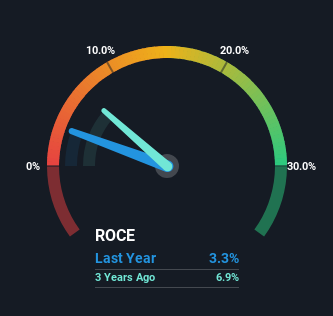- Hong Kong
- /
- Communications
- /
- SEHK:1720
Capital Allocation Trends At Putian Communication Group (HKG:1720) Aren't Ideal
Finding a business that has the potential to grow substantially is not easy, but it is possible if we look at a few key financial metrics. Ideally, a business will show two trends; firstly a growing return on capital employed (ROCE) and secondly, an increasing amount of capital employed. Put simply, these types of businesses are compounding machines, meaning they are continually reinvesting their earnings at ever-higher rates of return. In light of that, when we looked at Putian Communication Group (HKG:1720) and its ROCE trend, we weren't exactly thrilled.
What Is Return On Capital Employed (ROCE)?
For those that aren't sure what ROCE is, it measures the amount of pre-tax profits a company can generate from the capital employed in its business. Analysts use this formula to calculate it for Putian Communication Group:
Return on Capital Employed = Earnings Before Interest and Tax (EBIT) ÷ (Total Assets - Current Liabilities)
0.033 = CN¥23m ÷ (CN¥1.2b - CN¥469m) (Based on the trailing twelve months to December 2023).
Therefore, Putian Communication Group has an ROCE of 3.3%. In absolute terms, that's a low return and it also under-performs the Communications industry average of 5.1%.
View our latest analysis for Putian Communication Group

While the past is not representative of the future, it can be helpful to know how a company has performed historically, which is why we have this chart above. If you want to delve into the historical earnings , check out these free graphs detailing revenue and cash flow performance of Putian Communication Group.
What Can We Tell From Putian Communication Group's ROCE Trend?
In terms of Putian Communication Group's historical ROCE movements, the trend isn't fantastic. Over the last five years, returns on capital have decreased to 3.3% from 22% five years ago. However it looks like Putian Communication Group might be reinvesting for long term growth because while capital employed has increased, the company's sales haven't changed much in the last 12 months. It's worth keeping an eye on the company's earnings from here on to see if these investments do end up contributing to the bottom line.
While on the subject, we noticed that the ratio of current liabilities to total assets has risen to 40%, which has impacted the ROCE. If current liabilities hadn't increased as much as they did, the ROCE could actually be even lower. And with current liabilities at these levels, suppliers or short-term creditors are effectively funding a large part of the business, which can introduce some risks.
Our Take On Putian Communication Group's ROCE
To conclude, we've found that Putian Communication Group is reinvesting in the business, but returns have been falling. Moreover, since the stock has crumbled 97% over the last five years, it appears investors are expecting the worst. All in all, the inherent trends aren't typical of multi-baggers, so if that's what you're after, we think you might have more luck elsewhere.
Since virtually every company faces some risks, it's worth knowing what they are, and we've spotted 3 warning signs for Putian Communication Group (of which 2 shouldn't be ignored!) that you should know about.
For those who like to invest in solid companies, check out this free list of companies with solid balance sheets and high returns on equity.
New: Manage All Your Stock Portfolios in One Place
We've created the ultimate portfolio companion for stock investors, and it's free.
• Connect an unlimited number of Portfolios and see your total in one currency
• Be alerted to new Warning Signs or Risks via email or mobile
• Track the Fair Value of your stocks
Have feedback on this article? Concerned about the content? Get in touch with us directly. Alternatively, email editorial-team (at) simplywallst.com.
This article by Simply Wall St is general in nature. We provide commentary based on historical data and analyst forecasts only using an unbiased methodology and our articles are not intended to be financial advice. It does not constitute a recommendation to buy or sell any stock, and does not take account of your objectives, or your financial situation. We aim to bring you long-term focused analysis driven by fundamental data. Note that our analysis may not factor in the latest price-sensitive company announcements or qualitative material. Simply Wall St has no position in any stocks mentioned.
About SEHK:1720
Putian Communication Group
An investment holding company, produces and sells optical fiber cables, communication copper cables, and structured cabling system products under the Hanphy brand name in the People's Republic of China, Hong Kong, and internationally.
Proven track record with slight risk.
Market Insights
Community Narratives



